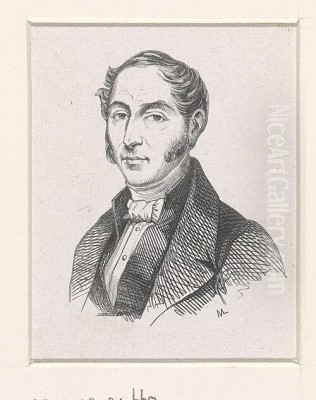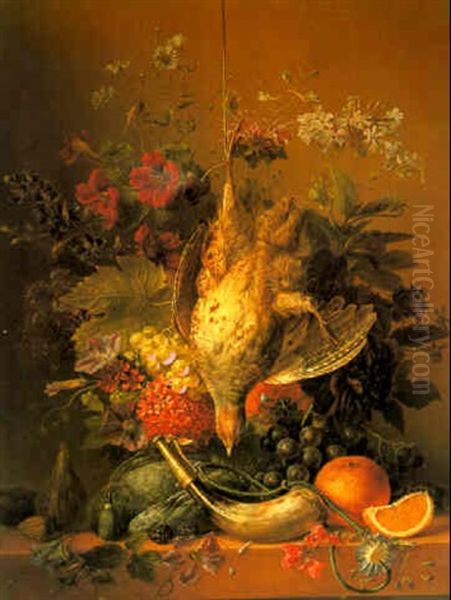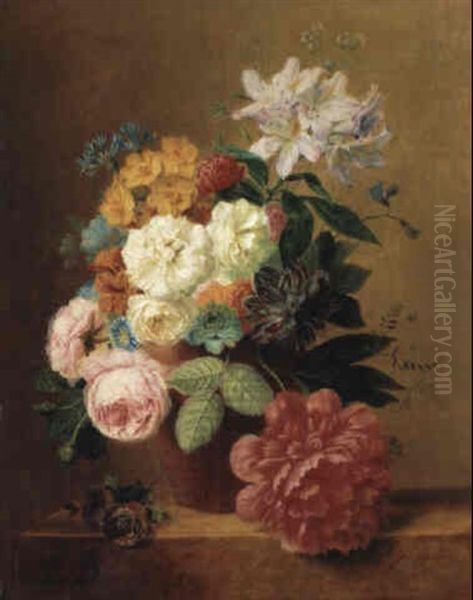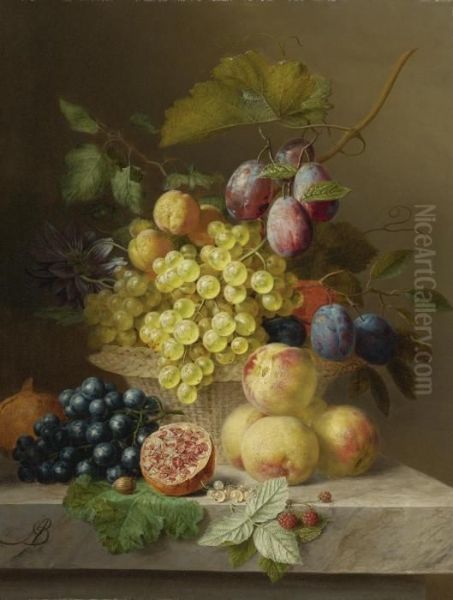
Arnoldus Bloemers stands as a significant figure in the lineage of Dutch still life painting, particularly celebrated for his exquisite floral compositions. Active in the first half of the 19th century, he inherited a rich artistic tradition and carved a niche for himself with works that combined meticulous detail, vibrant colour, and a profound appreciation for the beauty of the natural world. His paintings serve as a bridge between the Golden Age masters and later developments in still life, demonstrating both a reverence for his predecessors and a distinct personal style.
Early Life and Artistic Formation
Born in Amsterdam in 1792, Arnoldus Bloemers entered a world where the legacy of Dutch artistic excellence, especially in still life, was deeply ingrained. The Netherlands had, for centuries, been a hub of artistic innovation, and the meticulous depiction of everyday objects, flowers, and food had reached unparalleled heights during the 17th-century Golden Age. It was within this cultural milieu that Bloemers began his artistic journey.
He received his formal training at the Academy in Amsterdam, a period crucial for honing his technical skills. His primary instructor was Antoine Piera, a painter of whom less is widely documented compared to his more famous contemporaries. While Piera would have provided foundational instruction, Bloemers' artistic compass soon pointed decisively towards the towering figures of Dutch still life, most notably Jan van Huysum. This admiration for Van Huysum became a defining characteristic of Bloemers' artistic development and output.
The decision to emulate Jan van Huysum was not a casual one. Van Huysum was, and remains, one of the most revered flower painters of all time, known for his incredibly detailed, luminous, and often complex arrangements. For a young artist like Bloemers, Van Huysum's work represented a pinnacle of achievement in the genre. This focused emulation shaped Bloemers' technique, his choice of subject matter, and the overall aesthetic of his paintings.
The Enduring Legacy of Dutch Still Life

To fully appreciate Arnoldus Bloemers' contribution, one must understand the profound tradition he inherited. The Dutch Golden Age of the 17th century saw an explosion in still life painting. Artists like Ambrosius Bosschaert the Elder (1573-1621) and his sons, along with Balthasar van der Ast (1593/94-1657), were pioneers in floral still life, creating meticulously detailed and often symbolically rich bouquets. Their works featured flowers from different seasons, impossibly blooming together, showcasing both botanical accuracy and artistic license.
Later in the 17th century, artists such as Rachel Ruysch (1664-1750) brought a new dynamism and elegance to flower painting. Ruysch, one of the most successful female painters of her era, was renowned for her dark, atmospheric backgrounds from which vibrant flowers emerged, often with a sense of movement and delicate asymmetry. Her compositions were less rigid than some earlier works, imbuing them with a more naturalistic, albeit still highly arranged, feel.
Simultaneously, other forms of still life flourished. Willem Claesz. Heda (1594-1680) and Pieter Claesz. (1597-1660) were masters of the "ontbijtje" (breakfast piece) and later, more opulent "pronkstilleven" (ostentatious still lifes), depicting tables laden with silverware, glassware, and foodstuffs with astonishing realism. Willem Kalf (1619-1693) took the pronkstilleven to new heights of luxury, with rich colours, dramatic lighting, and exotic objects like Chinese porcelain and Turkish carpets. This broader context of meticulous realism and appreciation for the tangible world informed all Dutch still life, including floral painting.
The Towering Influence of Jan van Huysum
Jan van Huysum (1682-1749) emerged in the late Golden Age and early 18th century, taking flower painting to an unprecedented level of refinement and popularity. His works were highly sought after by collectors across Europe. Van Huysum was known for his lighter, airier backgrounds compared to the darker grounds favored by artists like Ruysch. He achieved an extraordinary luminosity in his flowers, with petals that seemed almost translucent.
Van Huysum's compositions were often more elaborate and gracefully arranged, featuring a profusion of different flower species, often accompanied by fruits, insects, and sometimes even a bird's nest. His attention to detail was legendary; every dewdrop, every insect wing, every subtle variation in petal texture was rendered with painstaking precision. He was also known for his secrecy regarding his techniques, particularly his methods for preparing pigments to achieve such vibrant and lasting colours. It was this master, with his bright palette, intricate compositions, and unparalleled realism, that Arnoldus Bloemers chose as his principal guide.
Bloemers' Artistic Style and Thematic Focus

Arnoldus Bloemers absorbed the lessons of Van Huysum thoroughly. His paintings are characterized by a similar dedication to botanical accuracy, a love for abundant floral arrangements, and a bright, often warm, colour palette. He typically depicted flowers in ornate vases, often placed on marble ledges, a compositional device frequently used by Van Huysum and other 17th and 18th-century masters.
Bloemers excelled in capturing the varied textures of different flowers: the velvety softness of a rose petal, the waxy sheen of a tulip, the delicate frills of a carnation. His works often feature a rich assortment of blooms, including roses, peonies, tulips, irises, poppies, and convolvulus, among others. Like Van Huysum, Bloemers frequently included meticulously rendered insects – butterflies, caterpillars, ants, and flies – crawling on leaves or petals. These tiny additions not only added to the realism but also subtly alluded to the transience of life and beauty, a common theme (vanitas) in Dutch still life, though perhaps less overtly emphasized in the 19th century than in the 17th.
His handling of light and shadow was delicate, creating a sense of volume and depth without resorting to overly dramatic chiaroscuro. The light often seems to gently illuminate the bouquet, highlighting the vibrant colours and intricate details. The overall effect is one of opulence, abundance, and a celebration of nature's ephemeral beauty. His style has been described as embodying the "Victorian-era" sensibility in flower arrangement, with full, lush bouquets that exude a sense of prosperity and cultivated taste.
Representative Masterpiece: "Still Life with Roses, Peonies, Tulips, Narcissi, Convolvulus and others in a Vase on a Marble Ledge"
One of Arnoldus Bloemers' most characteristic and celebrated works is titled "Still Life with Roses, Peonies, Tulips, Narcissi, Convolvulus and others in a Vase on a Marble Ledge." This painting encapsulates many of the defining features of his style and his debt to Jan van Huysum. The composition is rich and overflowing, with a diverse array of flowers meticulously arranged in an elegant vase.
The choice of flowers – roses, peonies, tulips, narcissi, and convolvulus – showcases Bloemers' ability to render different forms and textures. Each bloom is individually characterized, yet contributes to a harmonious whole. The colours are vibrant and varied, from deep reds and pinks to bright yellows and whites, all set against the cooler tones of the foliage and the marble ledge. The marble itself is rendered with a convincing sense of coolness and solidity, providing a stable base for the exuberant floral display.

True to his meticulous approach, Bloemers includes minute details such as dewdrops on petals and tiny insects, enhancing the painting's realism and inviting close inspection. The play of light across the arrangement is subtle yet effective, giving volume to the flowers and creating a sense of depth. This work, like many of his others, demonstrates his mastery of technique and his deep appreciation for the subject matter. It is a testament to the enduring appeal of floral still life and Bloemers' skill in continuing this distinguished Dutch tradition.
Contemporaries and the Dutch Art Scene in the Early 19th Century
Arnoldus Bloemers was working during a period of transition in Dutch art. The Golden Age was long past, and new artistic currents, including Romanticism and later Realism, were beginning to take hold across Europe. While Bloemers remained firmly rooted in the still life tradition, he was part of a broader artistic community.
One notable contemporary who also specialized in still life, particularly flowers and fruit, was Jan van Os (1744-1808). Although Van Os belonged to a slightly earlier generation, his career overlapped with Bloemers' formative years, and his work would have been known. Jan van Os, like Bloemers, was influenced by Jan van Huysum, and his paintings share a similar dedication to detailed realism and lush compositions. Van Os himself came from an artistic family; his father was the painter Jan van Os the Elder, and his children, including Pieter Gerardus van Os (1776-1839), who was known for landscapes and animal paintings, and Maria Margaretha van Os (1779-1862), a flower painter, also became artists. Jan van Os was taught by Aert Schouman (1710-1792), a versatile artist known for paintings of birds, still lifes, and decorative works.
The early 19th century in the Netherlands also saw the influence of Romanticism, though it manifested differently than in countries like Germany or France. Dutch Romanticism often found expression in landscapes, seascapes, and historical scenes. Painters like Herman Frederik Carel ten Kate (the painter, 1822-1891), though younger than Bloemers, represented this trend with his historical genre scenes. The provided information also lists Pieter Constant Boon in a similar context, suggesting his involvement in the Dutch Romantic movement, though his specific artistic contributions in painting would require further detailed research to distinguish from other individuals named Pieter Boon active in different fields. The teachers of H.F.C. ten Kate, such as Jacobus van der Stok and Kaspar Karsen (a cityscape painter), were also part of this evolving artistic landscape.

While Bloemers focused on still life, the broader artistic environment was one of diverse specializations. The academies, like the one Bloemers attended in Amsterdam, continued to provide traditional training, emphasizing drawing and the study of old masters. This academic grounding, combined with a specialized focus, allowed artists like Bloemers to achieve a high degree of technical proficiency in their chosen genre.
Artistic Legacy and Historical Evaluation
Arnoldus Bloemers passed away in The Hague in 1844, at the age of 52. During his lifetime and in the decades that followed, his work was well-regarded. He was seen as a worthy successor to the great tradition of Dutch floral painting, particularly as an inheritor of Jan van Huysum's mantle. His paintings were admired for their technical skill, their beauty, and their fidelity to nature.
Art historian J. Immerzeel, in his 19th-century dictionary of artists, praised Bloemers, noting his exceptional talent. Such contemporary or near-contemporary accounts affirm his reputation. His works found their way into significant collections, and today, examples of his paintings are held in museums, including the Museum Boijmans Van Beuningen in Rotterdam. This institutional recognition underscores his importance within the history of Dutch art.
While some art historical narratives might view artists who closely emulate past masters as less innovative, Bloemers' dedication to the established conventions of floral still life, executed with such high skill, has its own merit. He was not seeking to revolutionize art but to perfect a beloved and highly demanding genre. In this, he succeeded admirably. His paintings offer a window into the continued appreciation for detailed naturalism and decorative elegance in the 19th century.
His work also serves as an important link in the chain of still life painting. The tradition did not die out after the Golden Age but was continued by dedicated artists like Bloemers, who adapted it to the tastes of their time while preserving its core values. He, along with others like Georgius Jacobus Johannes van Os (1782-1861), son of Jan van Os and another distinguished flower painter who worked in Paris, ensured that the art of floral depiction remained vibrant.
Conclusion
Arnoldus Bloemers was a Dutch painter who dedicated his career to the art of still life, with a particular focus on floral compositions. Deeply influenced by the 17th and 18th-century masters, especially Jan van Huysum, he developed a style characterized by meticulous detail, vibrant colours, and lush, abundant arrangements. His works, such as "Still Life with Roses, Peonies, Tulips, Narcissi, Convolvulus and others in a Vase on a Marble Ledge," exemplify his technical prowess and his ability to capture the ephemeral beauty of nature.
Working in the first half of the 19th century, Bloemers upheld a rich artistic heritage, contributing to the continuation of a genre that had brought Dutch art international acclaim. While perhaps not an innovator in the dramatic sense, his mastery within the established framework of floral painting earned him considerable respect. His legacy is preserved in his beautiful canvases, which continue to be admired for their elegance, realism, and the sheer joy they convey in the depiction of the floral world. He remains an important figure for understanding the evolution of Dutch still life painting beyond its famed Golden Age.